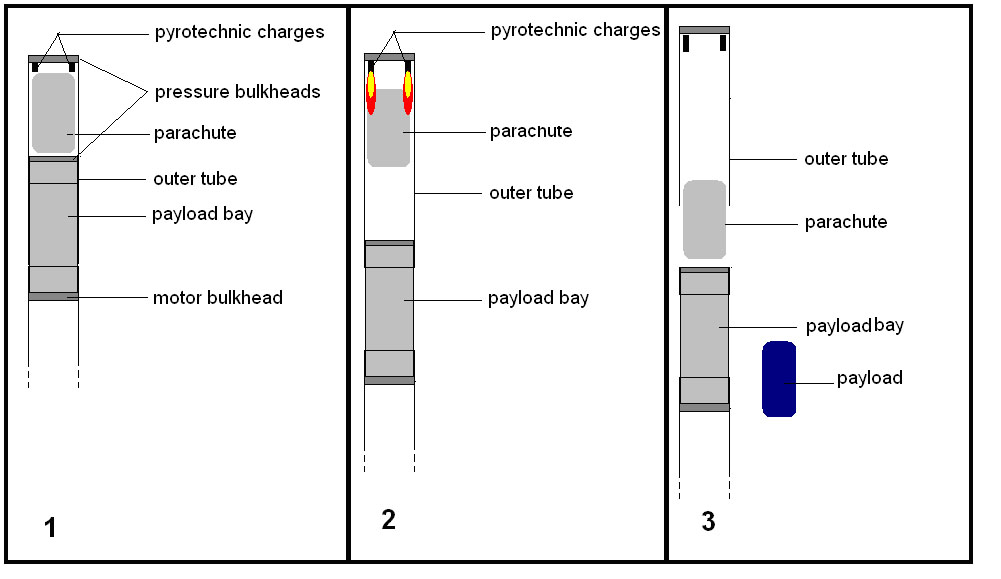CanSat Launcher V1
From Dare
At IAF Fukuoka 2005, a DARE member participated in the CanSat workshop. Back in the Netherlands he shared his experience with Dr.ir. C. Verhoeven of the faculty of Electrical Engineering. After this conversation he was so enthusiastic about this project that he asked us (DARE) to build a rocket that would be able to carry the CanSats.
Contents |
the design
The first CanSat Launcher made use of the dx1.2 engine. It was kept into place with some MDF rings and a MDF pressure bulkhead. On top of the motor part the separation mechanism was placed. The separation mechanism consisted of two parts, which could slide over each other: an outer tube and an inner tube, which was also the payload bay. The parachute was attached to both parts and packed above the payload bay, in the outer tube. A pressure bulkhead was attached to the upper part of the payload bay, effectively acting as a plunger. Such a bulkhead was also present at the upper part of the outer tube. In this part, two pyrotechnic charges were attached. When these charges are ignited, the rocked separates in two parts and the payload and parachute are forced out. In the top part the electronics where placed. The original plan was to use a commercial R-das and the in house developed MicroDAREDAS V2.0. Unfortunately the MicroDAREDAS V2.0 was not completed in time. The nosecone was made from foam, which was turned on a home made turning lathe.
the preperations
There is a movie covering the preparations of this rocket. This movie is made by Frank E. The preparations consist of producing and placing the black powder charges. Connect them to the electronics. Fill the engine for two third with propellant and place the engine in the rocket. Two problems where discovered during the preparations. The Simulation of NAVRO suggested that the rocket would reach a lower altitude as predicted by us. That's why the backup timer on the R-das had to be reprogrammed for earlier deployment. The second problem was discovered on the launch platform. The payload bay was to small for the CanSat. This is why one bulkhead had to be removed.
launch
The launch of this rocket took place at ASK ‘t Harde on the 28th of April 2006. Weather conditions were pretty good. There were almost no clouds. Wind speed was unknown, but the wind was blowing from the northwest quite strong. The ignition went well. The launcher came out of the tower with a relatively low speed, but was stable, and thus the flight path was quite straight. The reached altitude was higher than expected (expected altitude was about 300 m, because of a relatively high rocket mass and a motor that was not pushed to its limits) At apogee, no parachute deployment was observed and the rocket came down ballistic. It crashed near the launch site. After examination of the crash site, it was found out that the igniters, whose function was to initiate parachute deployment and cansat ejection, were not ignited.
possible cause of failure
Since the igniters did not ignite (a few days later, they were tested, and they ignited without a problem) the problem most likely to be related to the electronics. The electronics part of the rocket consisted of a commercial main flight controller, called “R-das” It detects lift-off by means of a G-switch (acceleration peak detector) and the igniters were activated at apogee. The most likely reason for the electronics to fail is not triggering the G-switch. Since the velocity with which the rocket left the tower was relatively low, so were the accelerations. These were probably not sufficiently large for the G-switch to trigger the electronics.




